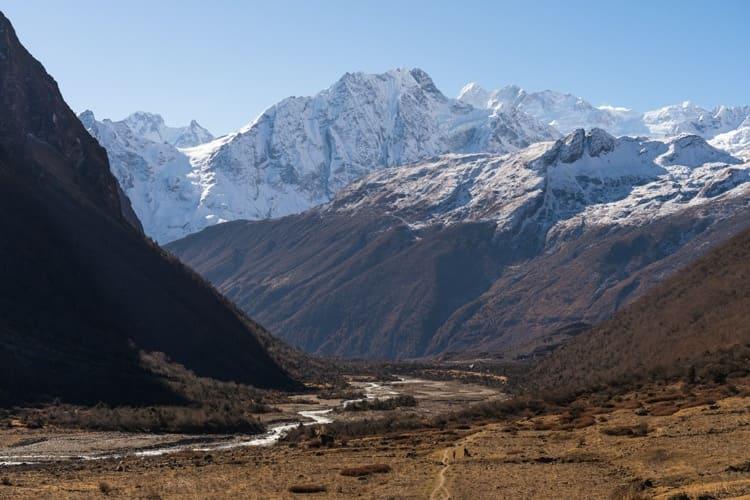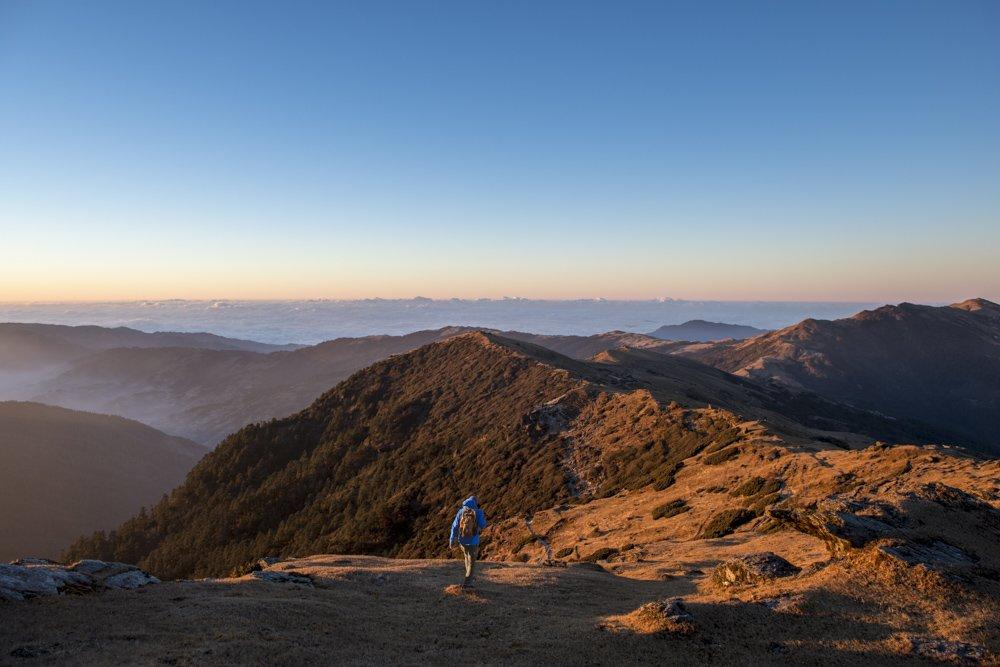Kanchanjunga base camp
- Author : Ghanendra Thapa
- Date : 29th September, 2024
- Time : 1 Min Read
- Euphoria
- Blog Detail
Thinking about a unique taste of wilderness trekking in Nepal, if so, Kanchenjunga Base Camp will be a perfect choice. A true paradise, one of the least visited off-the-beaten trek lies in an isolated place in Northern Nepal.
Kanchenjunga is the third-highest mountain in the world with an altitude of 8,586 Meters and was assumed to be the highest mountain until 1,852. Thanks to the Great Trigonometrical Survey of India concluded that Mount Everest which was known as Peak XV was the highest mountain in 1,849.
Kanchenjunga in a broader sense means, ‘The Five Treasures of the Great Snow’, which includes a range of 5 highest mountains over 8000+ meters standing in a row. This includes Kanchenjunga Main (8,586M), Yalongkang (8,505M), Kanchenjunga West (8,420M) and Twin Peaks (8,476M).
This entire range of Himalayas that run from North to South makes a borderline between Nepal and Sikkim, a state in India where the Glacier of Kanchenjunga joins the popular Tamur River in Nepal and finally joins the great Koshi Rive and flows back to India.
Exploring a range of Himalayas including 5 Peaks together above 8000+ meters is only possible when trekkers explore the Kanchenjunga Trail.
There were many attempts made to climb Mount Kanchenjunga, however, it was only on 25 May 1955 that Joe Brown and George Band from Britain made a successful summit. This expedition was conducted by a British expedition who had led a team to Mount Everest some two years earlier.
However, due to religious significance climbers never dare to steep at the summit point of Mount Kanchenjunga and still the practice keeps going. Mount Kanchenjunga has always been worshipped by the people of Nepal and India and before the summit, climbers have to ensure that they will remain at least 5 vertical feet below the summit point concerning the locals' sentiments.
Trekking to the Base Camp of Mount Kanchenjunga will take you through the bio-diversity of nature. The entire area falls under the Kanchenjunga Conservation Area and is also a restricted area. So trekkers will need to have a Special Permit from the Department of Immigration for the Kanchenjunga Base Camp Trek.
This can only be applied through the local travel and trekking agency in Nepal. Apart from this, a minimum of two trekkers has to go for the trek accompanied by a professional guide. Due to high altitude and remoteness, the area is less populated as compared to Everest Region and Annapurna Region.
Moreover, this trek is highly suitable and suggested for all age groups and genders who prefer to explore the Himalayas, remoteness, and wilderness of the Himalayan areas. Trekkers will encounter fewer travelers. So the trail remains less crowded and more isolated and the bio-diversity of nature is one of the highlights of the entire trek.
Kanchenjunga is possibly the only National park that covers 3 different countries and is popularly known as Tri-National Park, which extends its area to Taplejung in Nepal, Sikkim in India, and Tibet in China. However, trekkers are only allowed to trek through the Conservation areas of Nepal, covering 2035 sq. km, and have been declared a 'Gift to the Earth’ as part of the WWF campaign in 2000.
Inhabited mainly by the Rai and Limbu communities, the Kanchenjunga area is blessed with a popular Temple of Pathibhara Devi, dedicated to Goddesses Durga, and is one of the popular pilgrimage sites.
Kanchenjunga Trek Route
Kanchenjunga Trek is a minimum of 14-day trips, starting from Kathmandu and ending in Kathmandu. However, the trek starts after a short flight from Kathmandu and then a drive to Sukethum and can be extended to 17 to 18 days depending upon the trail route.
Acclimatizing yourself, you will reach the highest altitude of 5143M at the base camp. However, trekkers are highly recommended to have at least 2 extra days as a reserve day before the international flight back home.
These extra days can be used as a rest day during the trek or can be used instead if the flight is delayed due to weather.
During the trek in some of the places we can use local Jeep on a sharing basis to shorten our trek but this is a seasonal off-road drive.
Kanchenjunga Trek Difficulty
Kanchenjunga is a moderate to strenuous hike. Starting from a jeep drive, you will be hiking through the forest, and villages, passing by rivers, and finally into the conservation area. This will be an easy hike where you will hike an average of 6-7 Hours every day.
Acclimatizing self will be one of the best ideas during the Kanchenjunga Trek. This helps in gaining stamina and also helps our body to cope with the level of oxygen at the high altitude. Thus, to make sure your trek goes well, we have made sure the overnight trek distance is maintained.
Best time for Kanchenjunga Base Camp Trek
Kanchenjunga is one of the wild and remote treks in Nepal. This will take you to the base of Mount Kanchenjunga through the conservation areas. Moreover, the area is the least populated, thus there will be fewer villages on the trial, mainly at the above 3500 Meters.
During the monsoon, the lower part of the trail receives heavy rainfall, leading to a flood in the river and stream and also the possibility of landslides. Rain mainly happens during June, July, and August till early September.
Apart from this, winter also will create problems for the Kanchenjunga trek, the higher altitude will receive snowfall, which might block the trail. Moreover, during the winter which is December and January, people living at the higher altitude descend to the lower altitude, abandoning their houses.
Hence, finding proper accommodation and food will be another problem during winter. Overall, we will recommend trekkers abandon the monsoon and winter period for this trek.
Thus, the best time for the Kanchenjunga Base Camp Trek will be February, March, April, May, September, October, and November.
Kanchenjunga Base Camp Trek Accommodation
Due to its remoteness, fewer trekkers dare to trek Kanchenjunga. However, for those who prefer to explore the exotic Himalayas, this is one of the best trails in Nepal.
There will be fewer trekkers and the trail will not be crowded. Locals are very friendly and welcoming, their hospitality is welcoming. Their culture and customs are unique and distinct from the other areas of Nepal.
One benefit of this remote trek is, that although less in numbers compared to other areas, there are tea houses everywhere. As the popularity of Kanchenjunga is increasing, locals are focusing on Homestay accommodation for travelers.
Throughout the trek, you will be spending nights in local houses and tea house lodges with locally grown foods.
Kanchenjunga Base Camp Trek Cost
Kanchenjunga Base Camp Trek is a bit expensive in comparison to the other popular areas of Nepal. The area falls to the northern part and is regarded as a remote area as well. The Cost for Kanchenjunga Base Camp Trek is determined by multiple factors, firstly it goes with the number of days.
Moreover, Kanchenjunga is a restricted area and special permits are required for this trek along with Kanchenjunga Conservation Area Permits.
Overall, the entire trek will cost between USD 2100- and USD 2500 Per Person. However, if the number of travelers increases the price per person declines.
Required Permits and Documents for Kanchenjunga Trek
Kanchenjunga is a remote as well as restricted area in Nepal, bordering Tibet and India. Trekkers will need 3 different Permits to enter the Kanchenjunga area. This includes Restricted Area Permits, Kanchenjunga Conservation Area Permits, and TIMS Permits.
Restricted Area Permits can be obtained through the Department of Immigration in Kathmandu with a valid passport copy and visa and this can only be obtained through a registered Trekking Agency in Nepal.
Alternative Short Way to Trek North Base Camp of Mount Kanchenjunga
As mentioned above, Kanchenjunga is a range of 5 Himalayas together over 8000+ meters and the Highest among those is known as KANCHENJUNGA (Main), and the BASE CAMP is known as NORTH BASE CAMP (5143M).
The main attraction for trekkers is to visit the base camp of Kanchenjunga (Main) because among the 5 existing Himalayas Kanchenjunga (Main) is the HIGHEST and the entire ranges of Himalayas is named after that.
Here, trekkers who lack a long vacation can easily visit the KANCHENJUNGA BASE CAMP in just 14-Days. Below is the Alternative Short way to follow the Kanchenjunga Base Camp itinerary.
Day 1: Flight to Bhadrapur and drive to Piddim (1756M)
Day 2: Drive to Taplejung (1820M)
Day 3: Drive to Sekathum (1585M)
Day 4: Trek to Amjilosa (2498M)
Day 5: Trek to Gyabla (2725M)
Day 6: Trek to Ghunsa (3424M)
Day 7: Trek to Khambachen (4050M)
Day 8: Rest Day, Day Hike to Jannu View Point
Day 9: Trek to Lhonak (4780M)
Day 10: Day Hike to Kanchenjunga Base Camp (5143M) and descend to Lhonak
Day 11: Descend to Ghunsa (3424M)
Day 12: Descend to Amjilosa (2498M)
Day 13: Descend to Sekathum and Drive to Taplejung (1820M)
Day 14: Drive from Taplejung to Bhadrapur and Flight to Kathmandu (1350M)
Leave A Comment:
Author
Related Blogs
1 min read
by Surbi
Tsum Valley trek
If you are looking for a different trek in the Nepal Himalayas, why not take a trip through the remote and secluded Tsum Valley? It has been open...
1 min read
by Sushila Thapa
Pikey peak trek
Pikey Peak Trek - Everything You Need To Know Swiss Family Treks Blog Posting Overview of Trek Pikey Peak Trek is the epitome of mountain trekki...
1 min read
by Swostika
Tsho Rolpa
Tsho Rolpa Lake trek is a beautiful trek in Nepal that takes trekkers around the high range of Rolwaling Valley in the East-Central part of Nepal....
Comments
asmita [ asmita11@gmail.com ]
description good
5th March, 2025
Donna Meyers [ jyvil@mailinator.com ]
Quibusdam suscipit i
26th October, 2024
Sigourney Rice [ caqal@mailinator.com ]
Qui veniam dolor cu
20th October, 2024



